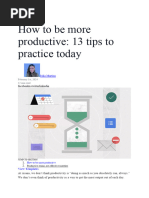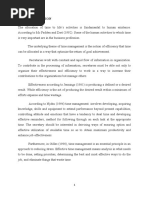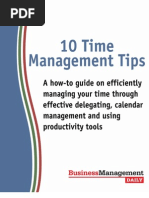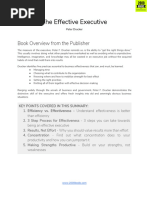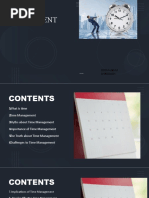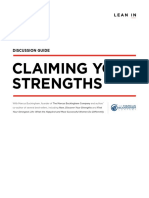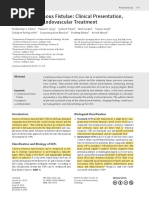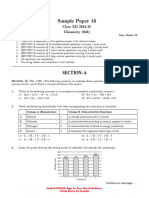10 Popular Time Management Techniques
10 Popular Time Management Techniques
Uploaded by
Nisha AnandCopyright:
Available Formats
10 Popular Time Management Techniques
10 Popular Time Management Techniques
Uploaded by
Nisha AnandCopyright
Available Formats
Share this document
Did you find this document useful?
Is this content inappropriate?
Copyright:
Available Formats
10 Popular Time Management Techniques
10 Popular Time Management Techniques
Uploaded by
Nisha AnandCopyright:
Available Formats
Musings, interviews, product stories & more to boost your digital marketing.
Brought to you by the people behind Brightpod.
Boost Interviews Popular Essentials Feed
TIME MANAGEMENT
10 Popular Time Management Techniques
September 9, 2014
Deadlines. Projects. Meetings. Proposals. Assignments. We’re constantly racing against the clock to
lessen our seemingly never-ending workload. If only we had 25 hours in a day! While that’s not
quite possible, perhaps what we need is not more time but instead, better time management.
Time is as good as gold — efficiency counts and that means maximizing your results with the least
amount of time. A good balance between work and play requires managing your time properly. After
all, all work and no play makes Jack a dull boy. Here are 10 popular time management techniques to
help you (and Jack) make time for the things that matter.
1. Pomodoro Technique
Developed in the late 1980s by Francesco Cirillo, the Pomodoro Technique is centred on the idea
that work should be broken down and completed in intervals separated by short breaks. That is, you
work for 25 minutes, then take a five minutes break. Each of these 25-minute periods is called a
“Pomodoro”, named after the Italian word for tomato. (Cirillo had used a tomato-shaped kitchen
timer, hence the name.) After 4 Pomodori, you take a longer break of 15–20 minutes. Of course,
nothing should interrupt an ongoing Pomodoro.
The philosophy behind this technique is simple — frequent breaks can improve mental agility,
letting you feel refreshed and recharged, ready to tackle new tasks. More importantly, it minimizes
any distractions, which these days come in the form of a Facebook message or a tweet. Pomodoro
forces these distractions to wait so that you can focus on your task. This also translates to higher
productivity in getting work done, and you can have more time to do other things.
2. Getting Things Done (GTD)
170
Image Source
The GTD method, developed by David Allen, starts by getting the user to write down all the things
he wants or needs to do, and then break them into smaller actionable items. The smaller tasks are
finished immediately, and the bigger tasks are divided into smaller ones to start completing now.
Because the tasks are recorded externally, this method works first by focussing attention on the task
itself, rather than on recalling them. The organization of tasks, for example grouping together
similar tasks, allows them to be easily managed. It also reduces anxiety which is an all-too-
common feeling when swamped with hundreds of things demanding our attention. GTD thus allows
you to better manage your work and time.
3. Important-Urgent Matrix
Popularized by Stephen Covey’s “The Seven Habits of Highly Effective People”, this 2x2 matrix is
another method to help users manage their time more effectively. On one axis, users classify tasks
that are important and not important. Urgent and not urgent tasks go on the other axis. The result is
4 quadrants: tasks that are important and urgent, important but not urgent, not important but
urgent, and lastly not important and not urgent.
Naturally, we tend to focus on tasks that are urgent. These could include some calls, interruptions or
distractions — it’s hard not to reach for your phone when it blinks with a new message. The matrix
helps to distinguish tasks that are truly urgent AND important, which should be attended to. On the
other hand, we tend to neglect important but not urgent tasks; this could include exercise and
vocation planning. Covey recommends that we focus on this quadrant to achieve effectiveness.
4. Pareto Analysis
Also called the 80–20 rule, this principle states that 80% of the tasks can be completed in 20% of
the time, while the remaining 20% of tasks will take up 80% of the time. In other words, 20% of
your work will constitute 80% of your achievements. Tasks that fall into the former category should
therefore by given a higher priority and doing so will help to increase productivity.
This principle is a useful tool for you to analyse where your time is currently spent, and
subsequently determine where it could better be directed to ensure time is spent wisely. The
analysis also encourages users to search for simpler and easier methods that are less time
consuming to complete each task.
5. Rapid Planning Method (RPM)
Created by Anthony Robbins, RPM aims to transform your thinking by causing you to focus on what
is truly important, that is, the results that you want. It also focuses on the reasons why you want it.
Constructing a flexible plan to achieve it is the next step. Robbins makes a distinction between real
progress and merely checking things off your to-do list.
RPM thus aims to be more than just a time management system — it fosters personal fulfilment
through the experience of your life journey.
6. 168 Hours
168 hours — that’s the number of hours there are in a week. And that’s how author Laura
Vanderkam proposes we look at our schedule — one week at a time. By reorganizing your time
according to your priorities, you can cut down on misused time that comes from misplaced
priorities or excuses.
Vanderkam believes that we actually have more time than we think and so we can devote more time
to the things we’ve always wanted to do but never quite found the time to do so.
7. Do It Now
Image Source
Steve Pavlina, self-help author, motivational speaker and entrepreneur, advocates a ‘do it now’
mentality. Whenever you’re feeling lazy when you know you should be doing something, reciting
the mantra ‘do it now’ and actually doing it will save you a lot of wasted time. Set this text as your
phone lock screen if you have to.
Pavlina explains that there’s extra cost in putting things off because you waste additional time
mentally thinking about what you have to do — instead of doing it. Pavlina also lives by a 60-second
rule for making decisions, whether big or small. Don’t waste time thinking about which assignment
to do — pick one and do it. There is no advantage in delaying decisions.
8. Do It Tomorrow
Hold up a second. Didn’t you just tell me to ‘do it now’? Mark Forster’s “Do It Tomorrow and Other
Secrets of Time Management” challenges traditional notions of time management techniques.
Forster recommends taking one task and focussing on it completely, which means ignoring the rest
altogether. The rationale behind this is that we have 2 mind sets while doing things — rational and
reactive. Your rational nature comes in when you’re focused on doing your task; reactive when
you’re dealing with interruptions. Thus when interrupted (which often happens if you don’t
completely focus on a task), you don’t just lose time when interrupted, you lose time switching
between the 2 natures as well.
So where does the title of this method fit in? Forster advocates a “will do” list which is the list of
things that you will do tomorrow. The “to do” list, on the other hand, is the list of things that you
would like to work on. The lists are by no means rigid — when you need more on your “will do” list,
draw from the “to do” list.
9. Eat that Frog
Image Source
Brian Tracy’s “Eat that Frog” comes from a Mark Twain saying “Eat a live frog the first thing in the
morning and nothing worse will happen to you the rest of the day.” So what does this mean? Your
frog is your most difficult and most important task — the one that you are going to procrastinate on
if you don’t do something about it. Doing this task first and getting it out of the way will make the
rest seem easier.
Knowing that you’ve completed that most dreaded thing will give you the momentum to keep going
and will give you a sense of empowerment.
10. Caffeine Nap
This last technique isn’t a time management technique per se, but it’s a useful tip to feel refreshed
so that you can keep going on. As oxymoronic as it sounds, a caffeine nap is actually backed up by
scientific evidence. Studies have shown that the sleep-deprived need only a cup of coffee and 15
minutes of nap to feel amazingly refreshed.
So how does it work? After drinking a cup of coffee, immediately close your eyes and relax, limiting
your nap to 15 minutes. Caffeine takes roughly 20 minutes to have an effect on your body, and so not
only will it not hinder your ability to sleep, but it will kick in about the time when you are
awakening. The result is a heightened state of alertness when you wake up, helping you to
concentrate better. So, if you’ve been either downing cup after cup of coffee or sleeping the
afternoon away, a combination of the two could work better for you.
Daniel is a Marketing Executive at ReferralCandy, and a sometimes writer-for-hire. He is madly
passionate about entrepreneurship, marketing, and productivity. His byline can be found all over the web,
but his home is at danieltay.me
Brightpod
Project management software for smart marketing teams.
TIME MANAGEMENT TIME MANAGEMENT
6 Incredible TED Talks Is Time Tracking Really
About Time Management Productive?
That’s the thing about watching It’s only recently that I have begun
TED Talks — you always find to appreciate the beauty of mapping
yourself feeling a whole lot more my time — personal and (mostly)
energized, motivated and beaming professional — with productivity
with a kind of positiv... apps....
PLAYLISTS
BRANDING BRIGHTPOD CONTENT MARKETING
CREATIVITY DESIGN DIGITAL MARKETING
EMAIL INSPIRATIONAL INTERVIEWS
INTERVIEWS 2013 - 2016 MARKETING AGENCY MARKETING PROJECT MANAGEMENT
PLANNING PRODUCTIVITY READING
REMOTE WORKING SEO SOCIAL
SOFTWARE STARTUP TEAMWORK
TIME MANAGEMENT WORK SMART
On the blog Brightpod Social
Interviews Project Planning & Tracking Twitter
Popular Tasks & Tasks Lists Facebook
Essentials Workflows Instagram
RSS Feed Editorial & Blogging Calendar
Focus Tasks
Work Priority List
Time Tracking
Email Integration
Insights & Reports
Storing Project Files
Manage & Track Project Milestones
Remote Team Communication
Marketing Requests
Personalisation Options
This website uses cookies to ensure you get the
best experience on our website. Learn more Universal Search
Got it!
SHARES © 2019 Brightpod. All Rights Reserved.
You might also like
- GTD-101 WorkbookDocument10 pagesGTD-101 Workbookyoachallenge100% (14)
- Shinko Turbine: Operation & MaintenanceDocument63 pagesShinko Turbine: Operation & MaintenanceYogi Pangaribuan100% (1)
- Cicobond EPDocument2 pagesCicobond EPmud44450% (2)
- E BookDocument27 pagesE BookukkuruNo ratings yet
- How To Be More ProductiveDocument13 pagesHow To Be More ProductiveAyman AliNo ratings yet
- English ResumeDocument6 pagesEnglish ResumeoverdosesteelkNo ratings yet
- Time ManagementDocument20 pagesTime Managementmo7amedsoliman2015No ratings yet
- ProductivityDocument6 pagesProductivitykintaronald9No ratings yet
- 10 Time Management HacksDocument2 pages10 Time Management HackssamuelteushdNo ratings yet
- How To Be More ProductiveDocument3 pagesHow To Be More ProductiveColeen gaboyNo ratings yet
- 03 NYJ - PS Planning and Prioritizing - v1Document31 pages03 NYJ - PS Planning and Prioritizing - v1aarush khatriNo ratings yet
- Organisational Behaviour ProjectDocument17 pagesOrganisational Behaviour Projectsujeetkothawale75% (4)
- Importance of 86440Document3 pagesImportance of 86440Malathi SvNo ratings yet
- Take Control of Your Time 2022Document40 pagesTake Control of Your Time 2022Jaqueline PerezNo ratings yet
- Time ManagementDocument21 pagesTime ManagementClifford JudeNo ratings yet
- The Protocol - The Protocol - The Executive's Guide To Efficient Task ManagementDocument6 pagesThe Protocol - The Protocol - The Executive's Guide To Efficient Task ManagementRahul KumarNo ratings yet
- 5 Steps For Better Time Management at WorkDocument2 pages5 Steps For Better Time Management at WorkrashahmdyNo ratings yet
- Notes For Methods To Master Your TimeDocument7 pagesNotes For Methods To Master Your Timejack.worth.575No ratings yet
- What Is Time Management SkillsDocument6 pagesWhat Is Time Management SkillsNiladri SenNo ratings yet
- PRODUCTIVITY HACKS FOR TECH PROFESSIONALS IN 2025Document5 pagesPRODUCTIVITY HACKS FOR TECH PROFESSIONALS IN 2025Ajose JohnNo ratings yet
- Task Management - A Complete Guide To Manage TasksDocument4 pagesTask Management - A Complete Guide To Manage TasksSINI WoftNo ratings yet
- Time Management & Communication SkillsDocument12 pagesTime Management & Communication SkillsIastraNo ratings yet
- Eight Time Management Tips For Software DevelopersDocument24 pagesEight Time Management Tips For Software DevelopersNida Saeed KhanNo ratings yet
- Chapter 2 Time Management (Part 1)Document19 pagesChapter 2 Time Management (Part 1)NOR SHADNI SHAHDINA SHAEFINo ratings yet
- Time ManagementDocument23 pagesTime Managementdaringdreu100% (3)
- Are You Making The Most of Your Time at Work?: Rate Your Time Management Skills and Find OutDocument2 pagesAre You Making The Most of Your Time at Work?: Rate Your Time Management Skills and Find OutPUTHI KAKNo ratings yet
- Mastering Time ManagementDocument4 pagesMastering Time Managementgnc9400No ratings yet
- Effective Executive v.2Document10 pagesEffective Executive v.2scoremaster ICSE JAVANo ratings yet
- 10 Tips For Boosting ProductivityDocument2 pages10 Tips For Boosting Productivitysarah1234bjjNo ratings yet
- Time Management StrategiesDocument8 pagesTime Management StrategiesMAXCDAY MICHAEL -No ratings yet
- Ctrlwork Time Management Course: ContentDocument6 pagesCtrlwork Time Management Course: ContentJanahvi JanardhanNo ratings yet
- The Productivity Workbook FullDocument86 pagesThe Productivity Workbook FullAmanda GonçalvesNo ratings yet
- Productivity Hacks - Simple Ways To Boost Your EfficiencyDocument14 pagesProductivity Hacks - Simple Ways To Boost Your Efficiencysundarniru13No ratings yet
- Time Mangement NikinDocument35 pagesTime Mangement NikinShweta MadhuNo ratings yet
- ExplainedDocument6 pagesExplainedEaterNo ratings yet
- IMPORTANCE OF TIME MANAGEMENT IN THE WORKPLACE IN 2022 22102022 025405pmDocument5 pagesIMPORTANCE OF TIME MANAGEMENT IN THE WORKPLACE IN 2022 22102022 025405pmAliza AurangzebNo ratings yet
- Foundr Productivity EbookDocument71 pagesFoundr Productivity EbookIna Eliza Dolganiuc100% (5)
- Mastering ProductivityDocument26 pagesMastering ProductivitysharathNo ratings yet
- Planning Time Management 1Document8 pagesPlanning Time Management 1KamauWafulaWanyama100% (1)
- 29 ThePomodoroTechnique ELearning 201901Document13 pages29 ThePomodoroTechnique ELearning 201901Joey MarantalNo ratings yet
- Time_Management_LessonsDocument13 pagesTime_Management_Lessonscristian.bitoleanuNo ratings yet
- Be More Productive Use Your Time WiselyDocument3 pagesBe More Productive Use Your Time WiselyDix TyNo ratings yet
- Article 1Document1 pageArticle 1abhi.0110111No ratings yet
- Term Paper of Mgt-512: Submitted To Submitted byDocument13 pagesTerm Paper of Mgt-512: Submitted To Submitted byBishop Singh100% (2)
- Time Management GuideDocument16 pagesTime Management Guidesas.bmasNo ratings yet
- Finals - Lesson 1 P1-ReviewerDocument3 pagesFinals - Lesson 1 P1-Reviewerjennymay.mamangunNo ratings yet
- How Timeboxing Works and Why It Will Make You More ProductiveDocument5 pagesHow Timeboxing Works and Why It Will Make You More ProductiveKrzysztof.PluteckiNo ratings yet
- Time Management Tips for Busy ProfessionalsDocument1 pageTime Management Tips for Busy Professionalsbarbaralopezu0cairuxNo ratings yet
- Basics of Everyday Planning and Tasks Management: Here Are The Basic Principles of GTDDocument4 pagesBasics of Everyday Planning and Tasks Management: Here Are The Basic Principles of GTDKSeegur100% (1)
- The Positive Mentality: Time Management, Sleep and Positive RoutinesFrom EverandThe Positive Mentality: Time Management, Sleep and Positive RoutinesNo ratings yet
- Why You Feel Unproductive and What To Do - LifeHackDocument40 pagesWhy You Feel Unproductive and What To Do - LifeHackwarriorscholar2212No ratings yet
- Time Management CompletionDocument13 pagesTime Management CompletionNansha MorganNo ratings yet
- List of Tips For Effective Time ManagementDocument1 pageList of Tips For Effective Time ManagementАнастасия ПроценкоNo ratings yet
- Time ManagementDocument61 pagesTime ManagementAmlan RoychowdhuryNo ratings yet
- Vitality-Oct EN-GENERIC 1015Document4 pagesVitality-Oct EN-GENERIC 1015TibelchNo ratings yet
- Chapter 2 - Time Management and Effective Telephone CommunicationDocument45 pagesChapter 2 - Time Management and Effective Telephone CommunicationHunt X JaxNo ratings yet
- Time ManagementDocument12 pagesTime ManagementAarav BalyanNo ratings yet
- doc4Document2 pagesdoc4Manish SharmaNo ratings yet
- Time Management - PresentationDocument17 pagesTime Management - PresentationShubham DixitNo ratings yet
- Innovation - How-Now-Wow Matrix - SessionLabDocument5 pagesInnovation - How-Now-Wow Matrix - SessionLabNisha AnandNo ratings yet
- Physics Project On Doppler S EffectDocument26 pagesPhysics Project On Doppler S EffectNisha AnandNo ratings yet
- Claiming Your Strengths: Discussion GuideDocument8 pagesClaiming Your Strengths: Discussion GuideNisha AnandNo ratings yet
- Nisha CEO 2016-2Document6 pagesNisha CEO 2016-2Nisha AnandNo ratings yet
- 8 Techniques For Self-Acceptance: Zen Habits PDFDocument3 pages8 Techniques For Self-Acceptance: Zen Habits PDFNisha AnandNo ratings yet
- Campus Connexions - CorporateDocument37 pagesCampus Connexions - CorporateNisha AnandNo ratings yet
- Ayurvedic Management of Cerebral Palsy: Report of Two Cases With Review of LiteratureDocument5 pagesAyurvedic Management of Cerebral Palsy: Report of Two Cases With Review of LiteraturesanjayNo ratings yet
- Admission 2020 21 PG 1 4 MDMSDocument4 pagesAdmission 2020 21 PG 1 4 MDMSMR. TachyonNo ratings yet
- 1 s2.0 S0141391014000913 MainDocument9 pages1 s2.0 S0141391014000913 Maintsing takNo ratings yet
- Supply Chain Problems & Solutions: Majid Al FuttaimDocument8 pagesSupply Chain Problems & Solutions: Majid Al FuttaimtinuNo ratings yet
- The Feasibility of Oregano ExtractDocument26 pagesThe Feasibility of Oregano ExtractVince RJ SilvestreNo ratings yet
- Fréquences Et Temps de Parcours Du REM: A High-Frequency MetroDocument5 pagesFréquences Et Temps de Parcours Du REM: A High-Frequency MetroJohn NganNo ratings yet
- 18PDH101L - General AptitudeDocument21 pages18PDH101L - General AptitudeMAHESHWAR M R (RA2111004010136)No ratings yet
- Soup Meaning and ClassificationDocument5 pagesSoup Meaning and ClassificationMelanNo ratings yet
- Basic Workshop Practices (R23) Exercises (1) - 1-25Document25 pagesBasic Workshop Practices (R23) Exercises (1) - 1-25Saravanan JNo ratings yet
- Operating Manual: LKHP Pump For High Inlet PressureDocument24 pagesOperating Manual: LKHP Pump For High Inlet Pressurepablo ortizNo ratings yet
- Copy B - To Be Filed With Employee's FEDERAL Tax Return. Copy 2 - To Be Filed With Employee's State, City, or Local Income Tax ReturnDocument1 pageCopy B - To Be Filed With Employee's FEDERAL Tax Return. Copy 2 - To Be Filed With Employee's State, City, or Local Income Tax Returnchaparroramirezbarboza1993No ratings yet
- Instant Access to Pediatric Orthopaedics and Sports Injuries: A Quick Reference Guide 3rd Edition John F. Sarwark Md Faap Faaos ebook Full ChaptersDocument40 pagesInstant Access to Pediatric Orthopaedics and Sports Injuries: A Quick Reference Guide 3rd Edition John F. Sarwark Md Faap Faaos ebook Full Chapterskhatmivigand100% (1)
- Daily House Cleaning Checklist TemplateDocument1 pageDaily House Cleaning Checklist TemplateNalendra UjiNo ratings yet
- CCF Clinical Presentation, Imaging, and Endovascular TreatmentDocument9 pagesCCF Clinical Presentation, Imaging, and Endovascular TreatmentmithaNo ratings yet
- SP 4 6 0 121aawDocument5 pagesSP 4 6 0 121aawshaggipcNo ratings yet
- 2020 DNB AnesthesiaDocument33 pages2020 DNB AnesthesiasreesaichowdaryNo ratings yet
- L3341 HeatSeal Insulated PEX Pipe Brochure 2009-07-28Document2 pagesL3341 HeatSeal Insulated PEX Pipe Brochure 2009-07-28Tanveer Alam AnsariNo ratings yet
- The Legacy of Shaw and McKayDocument31 pagesThe Legacy of Shaw and McKayNap GonzalesNo ratings yet
- P-1. &. I Clubs Law and Practice - CHAPTER 2 Structure of A Modern P&I ClubDocument1 pageP-1. &. I Clubs Law and Practice - CHAPTER 2 Structure of A Modern P&I ClublostnfndNo ratings yet
- Muscular System PowerPointDocument11 pagesMuscular System PowerPointEmerald CorrineNo ratings yet
- Open Letter To Congress From Health Care Policy ExpertsDocument25 pagesOpen Letter To Congress From Health Care Policy ExpertsKFFHealthNewsNo ratings yet
- 02 MCT Product Data SheetsDocument12 pages02 MCT Product Data SheetskunalscribduomNo ratings yet
- Hair Analysis - The Whole Story, Not QuackWatch'sDocument28 pagesHair Analysis - The Whole Story, Not QuackWatch'sGary Moller100% (3)
- Ba25 e ThesisDocument2 pagesBa25 e ThesisandygulleNo ratings yet
- Impengement SyndromeDocument39 pagesImpengement Syndromewahyu_sitaNo ratings yet
- Salt Fog Chamber BrochureDocument4 pagesSalt Fog Chamber BrochureLuis moralesNo ratings yet
- Sec 5 Se 999Document5 pagesSec 5 Se 999Jhon HernandezNo ratings yet
- Cblechpu 16Document6 pagesCblechpu 16dhanyashreedhachiNo ratings yet




